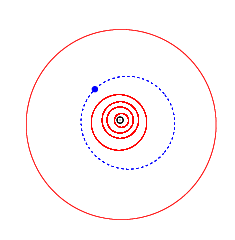9994 Grotius
Topic: Astronomy
 From HandWiki - Reading time: 4 min
From HandWiki - Reading time: 4 min
 Orbit of Grotius (blue), inner planets and Jupiter (outermost) | |
| Discovery [1] | |
|---|---|
| Discovered by | C. J. van Houten I. van Houten-G. T. Gehrels |
| Discovery site | Palomar Obs. |
| Discovery date | 24 September 1960 |
| Designations | |
| (9994) Grotius | |
| Pronunciation | /ˈɡroʊʃiəs/[3] |
| Named after | Hugo Grotius (Dutch jurist)[2] |
| 4028 P-L · 1981 WH9 | |
| Minor planet category | main-belt · (middle) Rafita |
| Orbital characteristics [1] | |
| Epoch 4 September 2017 (JD 2458000.5) | |
| Uncertainty parameter 0 | |
| Observation arc | 55.59 yr (20,306 days) |
| |{{{apsis}}}|helion}} | 3.0391 AU |
| |{{{apsis}}}|helion}} | 2.1307 AU |
| 2.5849 AU | |
| Eccentricity | 0.1757 |
| Orbital period | 4.16 yr (1,518 days) |
| Mean anomaly | 204.01° |
| Mean motion | 0° 14m 13.92s / day |
| Inclination | 7.1806° |
| Longitude of ascending node | 207.15° |
| 224.33° | |
| Physical characteristics | |
| Dimensions | 3.38 km (calculated)[4] 3.746±0.146 km[5][6] |
| Rotation period | 9.219±0.0067 h[7] |
| Geometric albedo | 0.20 (assumed)[4] 0.263±0.040[5][6] |
| S [4] | |
| Absolute magnitude (H) | 14.2[5] · 14.273±0.007 (R)[7] · 14.3[1] · 14.48±0.45[8] · 14.72[4] |
9994 Grotius /ˈɡroʊʃiəs/, provisional designation 4028 P-L, is a stony Rafita asteroid from the middle regions of the asteroid belt, approximately 3.5 kilometers in diameter. It was discovered during the Palomar–Leiden survey in 1960, and named after Dutch jurist Hugo Grotius.
Discovery
Grotius was discovered on 24 September 1960, by the Dutch astronomers Ingrid and Cornelis van Houten, on photographic plates taken by Dutch–American astronomer Tom Gehrels at Palomar Observatory in California, United States.[9]
Survey designation
The survey designation "P-L" stands for Palomar–Leiden, named after Palomar Observatory and Leiden Observatory, which collaborated on the fruitful Palomar–Leiden survey in the 1960s. Gehrels used Palomar's Samuel Oschin telescope (also known as the 48-inch Schmidt Telescope), and shipped the photographic plates to Ingrid and Cornelis van Houten at Leiden Observatory where astrometry was carried out. The trio are credited with the discovery of several thousand minor planets.[10]
Orbit and classification
Grotius orbits the Sun in the central main-belt at a distance of 2.1–3.0 AU once every 4 years and 2 months (1,518 days). Its orbit has an eccentricity of 0.18 and an inclination of 7° with respect to the ecliptic.[1] The body's observation arc begins with its official discovery observation at Palomar.[9]
Rotation period
In August 2010, a rotational lightcurve of Grotius was obtained from photometric observations in the R-band at the Palomar Transient Factory in California. Lightcurve analysis gave a rotation period of 9.2189 hours with a brightness variation of 0.27 magnitude ({{{1}}}).[7]
Diameter and albedo
According to the survey carried out by the NEOWISE mission of NASA's Wide-field Infrared Survey Explorer, Grotius measures 3.746 kilometers in diameter and its surface has an albedo of 0.263.[5][6] The Collaborative Asteroid Lightcurve Link assumes a standard albedo for stony asteroids of 0.20 and calculates a diameter of 3.38 kilometers based on an absolute magnitude of 14.72.[4]
Naming
This minor planet was named for Dutch jurist Hugo Grotius (1583–1645), who laid the foundations for international law, based on natural law.[2] He was a child prodigy and entered Leiden University when he was just eleven years old. The approved naming citation was published by the Minor Planet Center on 11 November 2000 (M.P.C. 41571).[11]
References
- ↑ 1.0 1.1 1.2 1.3 "JPL Small-Body Database Browser: 9994 Grotius (4028 P-L)". Jet Propulsion Laboratory. https://ssd.jpl.nasa.gov/sbdb.cgi?sstr=2009994.
- ↑ 2.0 2.1 Schmadel, Lutz D. (2007). "(9994) Grotius". Dictionary of Minor Planet Names – (9994) Grotius. Springer Berlin Heidelberg. p. 716. doi:10.1007/978-3-540-29925-7_7782. ISBN 978-3-540-00238-3.
- ↑ Noah Webster (1884) A Practical Dictionary of the English Language
- ↑ 4.0 4.1 4.2 4.3 4.4 "LCDB Data for (9994) Grotius". Asteroid Lightcurve Database (LCDB). http://www.minorplanet.info/PHP/generateOneAsteroidInfo.php?AstInfo=9994%7CGrotius.
- ↑ 5.0 5.1 5.2 5.3 Mainzer, A.; Grav, T.; Masiero, J.; Hand, E.; Bauer, J.; Tholen, D. et al. (November 2011). "NEOWISE Studies of Spectrophotometrically Classified Asteroids: Preliminary Results". The Astrophysical Journal 741 (2): 25. doi:10.1088/0004-637X/741/2/90. Bibcode: 2011ApJ...741...90M.
- ↑ 6.0 6.1 6.2 Masiero, Joseph R.; Mainzer, A. K.; Grav, T.; Bauer, J. M.; Cutri, R. M.; Dailey, J. et al. (November 2011). "Main Belt Asteroids with WISE/NEOWISE. I. Preliminary Albedos and Diameters". The Astrophysical Journal 741 (2): 20. doi:10.1088/0004-637X/741/2/68. Bibcode: 2011ApJ...741...68M. http://adsabs.harvard.edu/cgi-bin/bib_query?bibcode=2011ApJ...741...68M. Retrieved 23 June 2017.
- ↑ 7.0 7.1 7.2 Waszczak, Adam; Chang, Chan-Kao; Ofek, Eran O.; Laher, Russ; Masci, Frank; Levitan, David et al. (September 2015). "Asteroid Light Curves from the Palomar Transient Factory Survey: Rotation Periods and Phase Functions from Sparse Photometry". The Astronomical Journal 150 (3): 35. doi:10.1088/0004-6256/150/3/75. Bibcode: 2015AJ....150...75W. http://adsabs.harvard.edu/cgi-bin/bib_query?bibcode=2015AJ....150...75W. Retrieved 23 June 2017.
- ↑ Veres, Peter; Jedicke, Robert; Fitzsimmons, Alan; Denneau, Larry; Granvik, Mikael; Bolin, Bryce et al. (November 2015). "Absolute magnitudes and slope parameters for 250,000 asteroids observed by Pan-STARRS PS1 - Preliminary results". Icarus 261: 34–47. doi:10.1016/j.icarus.2015.08.007. Bibcode: 2015Icar..261...34V. http://adsabs.harvard.edu/cgi-bin/bib_query?bibcode=2015Icar..261...34V. Retrieved 23 June 2017.
- ↑ 9.0 9.1 "9994 Grotius (4028 P-L)". Minor Planet Center. https://www.minorplanetcenter.net/db_search/show_object?object_id=9994.
- ↑ "Minor Planet Discoverers". Minor Planet Center. 24 April 2016. https://www.minorplanetcenter.net/iau/lists/MPDiscsNum.html.
- ↑ "MPC/MPO/MPS Archive". Minor Planet Center. https://www.minorplanetcenter.net/iau/ECS/MPCArchive/MPCArchive_TBL.html.
External links
- Asteroid Lightcurve Database (LCDB), query form (info )
- Dictionary of Minor Planet Names, Google books
- Asteroids and comets rotation curves, CdR – Observatoire de Genève, Raoul Behrend
- Discovery Circumstances: Numbered Minor Planets (5001)-(10000) – Minor Planet Center
- 9994 Grotius at AstDyS-2, Asteroids—Dynamic Site
- 9994 Grotius at the JPL Small-Body Database
 |
 KSF
KSF